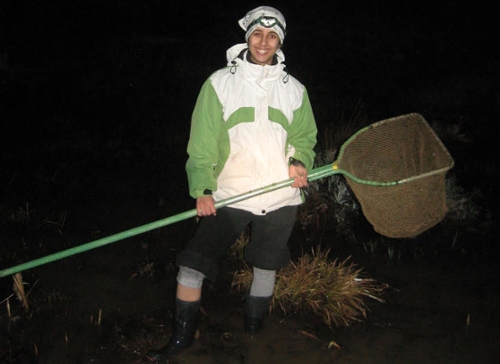Assistant Professor Clara do Amaral
Extreme cold-adapted creatures: Frogs that freeze

Clara do Amaral
Tiny Alaskan wood frogs (Rana sylvatica) freeze solid in winter—their hearts not beating, oxygen not flowing through their ice-filled bodies—then quickly resume normal life after thawing in the spring.
Clara do Amaral, assistant professor of biology at Mount St. Joseph University (Miami Ph.D. '14), and her colleagues at Miami University are discovering some of the frogs’ secrets, including the accumulation of certain chemicals in their bodies.
Discovering how these animals can freeze and thaw—and thrive—could one day lead to figuring out how to freeze and later thaw human organs for transplantation and other medical applications.
The wood frog uses cryoprotectants—substances that prevent freezing of tissues or damage to cells during freezing — to help them survive being frozen for at least two months straight.
Do Amaral works with Jon Costanzo, adjunct professor of biology at Miami, researching the environmental and physiological factors to determine the cryoprotectant strategies used by freeze-tolerant frogs.
Her post-doctoral research on another freeze-tolerant frog, Cope’s gray treefrog, led to the first study that analyzed real-time gene expression in frozen frogs at a large scale using RNA sequencing. They discovered that these frogs use a triple cryoprotectant system of glycerol, urea and glucose.
She and her student researchers at Mount St. Joseph are currently investigating cryoprotectant strategies used by freeze-tolerant frogs, as well the possible side-effects of cryoprotectant accumulation in these animals.
Do Amaral began studying studying amphibian and reptile biology as an undergraduate student at the University of Lisbon, Portugal.
At Miami, she conducted her doctoral dissertation research (2009-2014) under the direction of Jon Costanzo, adjunct professor of biology and senior research scientist, and Richard Lee, University Distinguished Professor of Biology. After a post-doctoral fellowship at the University of Dayton, she joined the faculty of Mount St. Joseph in 2017.
Her research has been supported by the National Science Foundation, Sigma Xi and the Portuguese Foundation for Science and Technology.
She is the recipient of the 2017 Research Recognition Award from the American Physiological Society.
Her work with Costanzo has been featured in three TV science programs: NOVA’s “Making Things Colder,” the David Attenborough production “Natural Curiosities,” and the BBC’s “Hidden Kingdoms.”

